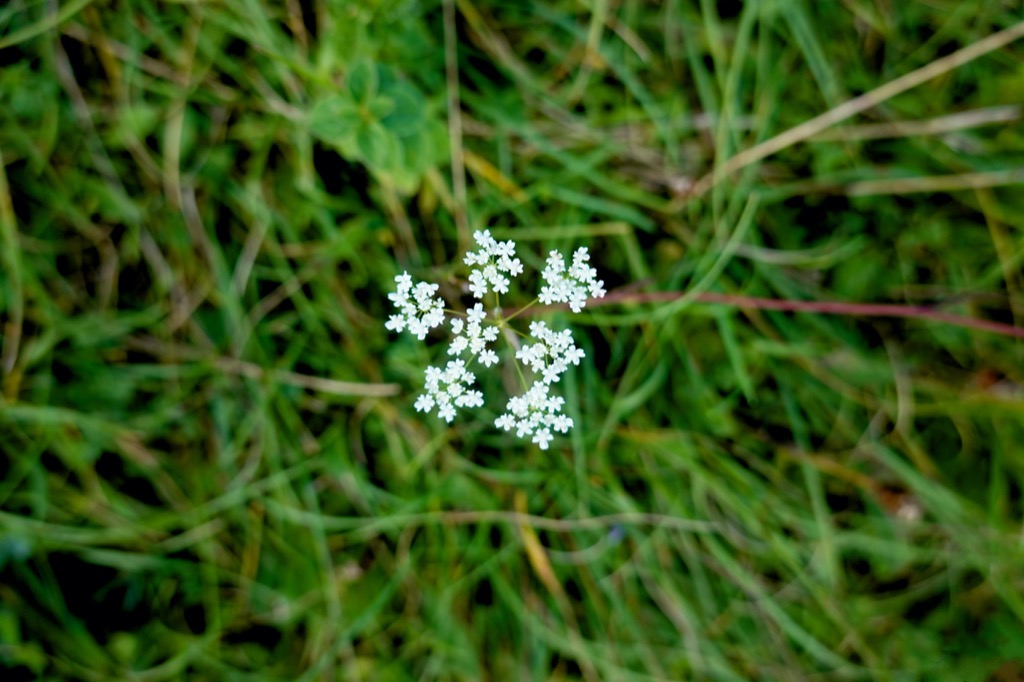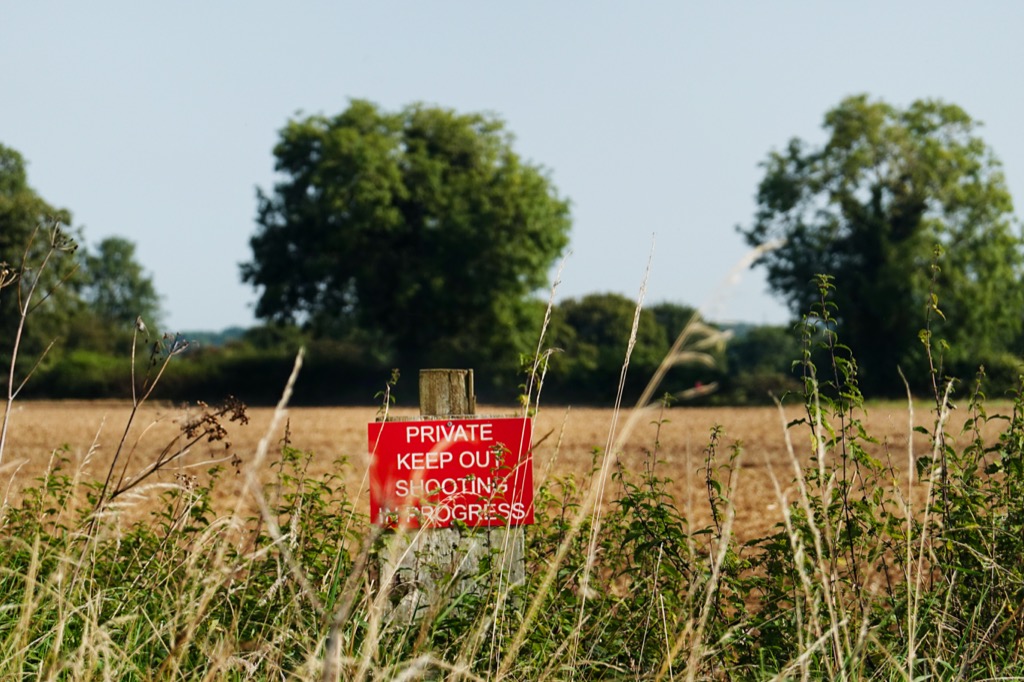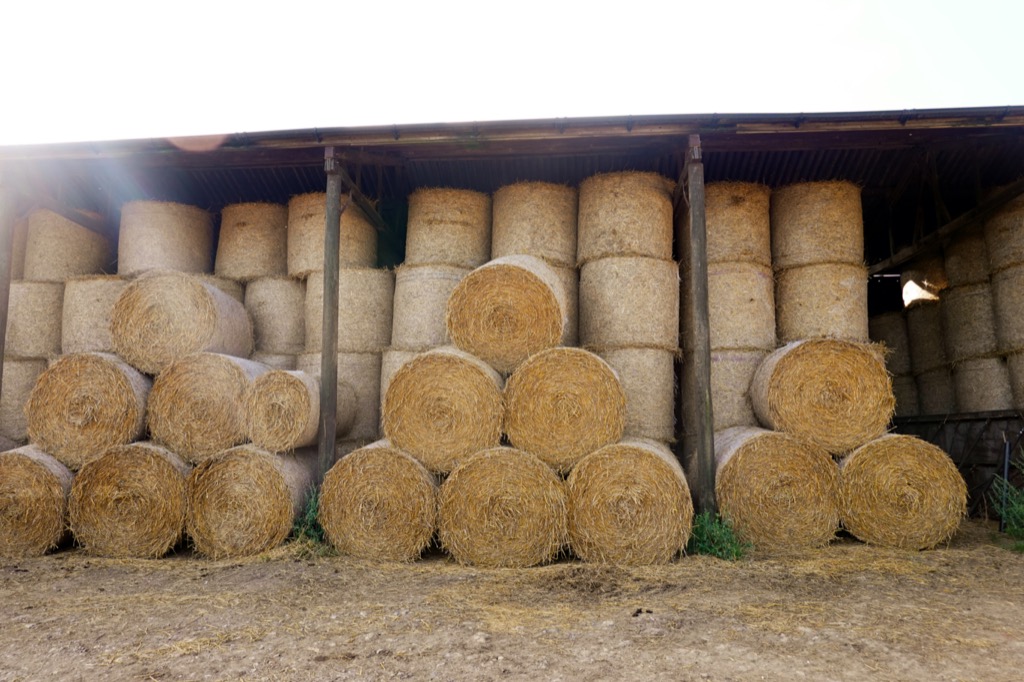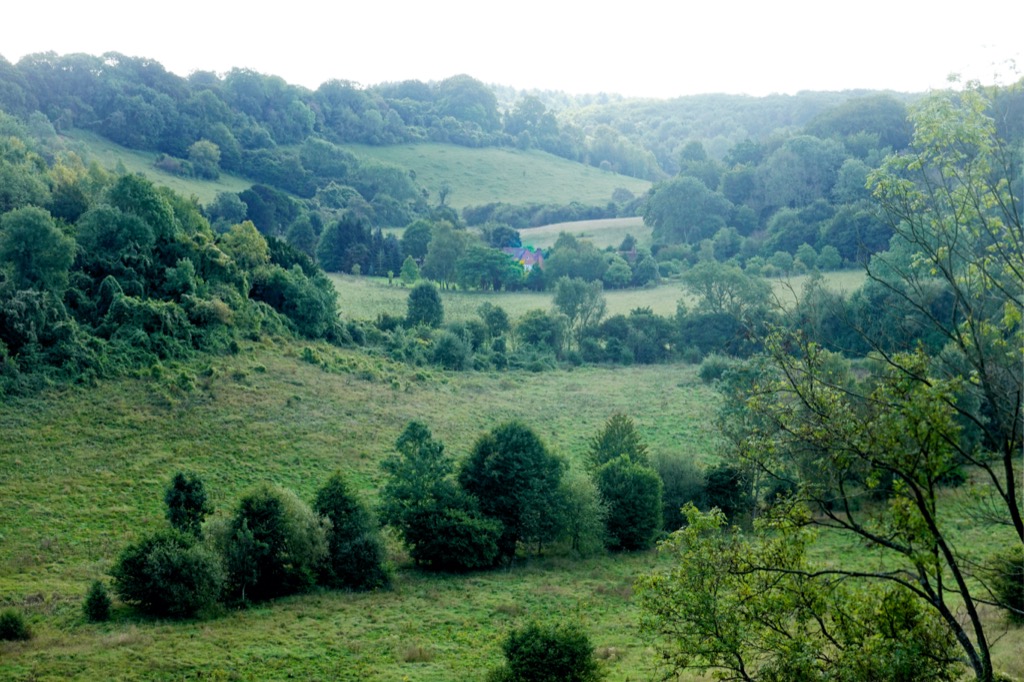[EDIT: you can read the stories from my progress across my map here.]
I got a good feeling about this grid square as soon as I arrived. The omens had been promising: plenty of contour lines on the map, zero roads, and on previous outings on my map I had looked in this direction and thought, “that looks really nice over there.”
There were bonus criteria too: the sun was blazing away, a real bonus late September gift. And this week had been the equinox and the official arrival of autumn so I was just noticing the green leaves beginning to turn on one or two trees. It is a time of year when, for once, it is easy to appreciate the here and now and be grateful for it: this kind weather will not be here for much longer now. I was on foot this week for a deliberate change of pace. Most of my map I have explored by bike. I wanted to appreciate the warm weather knowing that it will soon be gone for eight months.
Already I was beginning to ask myself, “could this be my favourite grid square?” It was actual, proper countryside and to my left was what seemed to be an actual, proper hill: something in woefully short supply on my map.
My legs were stiff from last night’s dark run – I always seem to turn to running once the nights draw in. It was my first run in a while so my legs felt heavy, my hamstrings hurt, my headphones seemed to jiggle about annoyingly, my reflective vest was too loose and bounced around – but these irritations were cancelled by the fun of watching huge clouds of my breath billowing in the misty torchlight and the thrill of a large white owl swooping across the road in front of me. This morning though is hot and bright. I peel off my jumper, wondering how many more weeks of t-shirt wearing exploring I have on this map. Walking feels so different to the running and walking that I usually do and I notice the way I think is different too.
It is a really quiet, still, blue sky morning in this empty valley (except for the distant motorway of course, but I prefer to imagine that is the sound of waves on a shore). I pass one field of harvested stubble which gives off a gentle ticking sound for some reason, like bubble bath popping. After that field, however, the valley feels abandoned and wild. It’s all a mixture of chalk grassland and scrub before turning to woodland at the top of the valley sides.
What I blithely call ‘scrub’ is actually loads of species that I don’t know. I put in a couple of minutes of effort with my Seek app to identify a few plants and find that I am amongst wild carrot, devil’s bit scabious, strawberry clover, agrimony, wild basil, thyme, oregano, ragwort, thistles and dog rose, not to mention all the different sorts of grasses, sparkling with morning dew and spiders’ webs. Insects chirp all around. This scrap of noticing and learning has made the grassland come more alive before my eyes. Wildflower meadows on chalk downland are sometimes called Europe’s tropical rainforest. They’re home to an incredibly rich and diverse range of plant and insect life. Up to 40 species of flowering plants can be found in one square metre of chalk grassland. Many species grow nowhere else, including many beautiful orchids and wildflowers. In turn, they attract many insects and rare butterflies such as the Adonis Blue and Duke of Burgundy.
Lime-rich, but low in nutrients, the thin soil holds little water and heats up quickly. These stressed conditions stop the dominant lush grasses from taking over. This allows a diverse range of smaller herbs and lower plants to flourish. Many ground beetles and different types of bee can be found amongst rarer insects such as the phantom hoverfly and wart-biter bush cricket. Rare butterflies such as the Silver spotted skipper and Adonis blue, and rare moths such as the Gothic moth and Four-spotted moth can also be found on chalk grassland.
We have lost more than 80% of our chalk grassland since the Second World War. This is mainly because of changes in land use from traditional low-level animal grazing. For instance, intensive farming with the use of herbicides and fertilisers changes the nature of the soil so that the traditional chalk grassland species can’t grow. Over grazing can prevent plants from flowering and seeding, whilst under grazing can allow scrub to take over.



There are bright red berries on a whitebeam tree I pass, and clusters of black berries on a Buckthorn (although it may be a Dogwood: I have no idea, to be honest, and am totally dependent on the AI mysteries of my app.) The hawthorn trees I am more certain of, with their distinctive leaves and red berries. In Gaelic this thorny shrub is known as sgitheach. Thomas the Rhymer, the thirteenth century Scottish mystic and poet met the Faery Queen by a hawthorn from which a cuckoo was calling. She led him into the Faery Underworld for a brief sojourn.
Medieval folk also asserted that the smell of hawthorn blossom was just like the smell of the Great Plague in London. Botanists later discovered the reason for this. The chemical trimethylamine present in hawthorn blossom is also formed in decaying animal tissue. In the past, when corpses were in the house for several days before burial, people would have been very familiar with the smell of death. So it is hardly surprising that hawthorn blossom was so unwelcome in the house.
During the autumn and winter, red fruits known as ‘haws’ appear. Common hawthorn is a rich habitat for all kinds of wildlife, from Hawthorn shield bugs and Yellowhammers that feed on the haws, to Wood mice and Slow worms that shelter in the thorny thickets. Traditionally hawthorn berries are used to make jellies, wines and ketchup. Honeybees foraging on hawthorn blossoms bring a harvest of dark amber and nutty hawthorn honey. The young leaves and shoots of common hawthorn are edible and were once known as “bread and cheese”.

The squawk-squawk of a pheasant’s alarm call causes me to look up, and sure enough I spot a fox slinking silently and patiently up the valley in the lee of a hedge. The sunlight is low and bright and the morning feels as though it is paused and waiting for something. This map that I live on has grown on me a lot this year. Up in the wood that I’m approaching a woodpecker calls out loudly and a bunch of jays are squabbling in the tree tops. I climb up the hill on a cool dark tunnel footpath through the woods. It still felt green and summery in the woods; definitely not yet autumn, although I was crunching over the mast (the nut crop) of beech trees. As I’ve seen sadly too often, many of the ash trees in the wood were marked for felling with neon orange paint, victims of the insidious ash dieback catastrophe.


An old man walked my way on the footpath and I stepped aside to allow him to pass with a nod of his head. He was the first person I had seen today, and it has been quite rare for me to see any people at all on the quiet paths I have been frequenting on my map. The man was slow, frail, stooped, with the skin on his face sagging and his eyes red rimmed and sunken. I reflect that I am as near to that age as I am to being a kid running around the playground. Don’t take my fitness for granted. Don’t take these days for granted.


Out of the woods once more and it was hot and bright as I followed the footpath across a ploughed towards a farm. Stands of maize had been left around the perimeter of the field to act as cover for the pheasants being reared for the local shoot. On the farm there were triangular towers of round bales stacked in barns, grain silos to feed the cattle, and an incongruous red canoe on top of a shed. Cattle chewed hay lugubriously in their pens and looked at me with big bored eyes.


Beyond the farm’s grassy grazing fields I passed through another strip of woodland and emerged, in astonishment, at the top of a beautiful valley. “Yes!” I declared to myself, grinning. “This is it.”
I was about halfway along the valley, which opened out in front of me, uninterrupted, for about two miles. Below me was a beautiful, steep valley filled with hedgerows, trees, untouched grassland and a large pond. I could see just one house, enviably nestled in the trees near the head of the valley.
“This is the most beautiful place on my map. I have found the treasure.”


I stared at the valley with eagle eyes, silently taking in the landscape and feeling moved by it in a way that I have deeply missed since lockdown kept me away from the properly wild landscapes of our country that I love so much. Wildness, silence, contour lines and trees: this valley had it all.
I was gazing very happily down upon my discovery when two hikers appeared behind me. Aware that I was paying close attention to the view, one of them said to me, “Such a shame, isn’t it?”
“What do you mean?” I asked, for that had not been the response I had anticipated.
“The golf course.” He explained. “All this was a golf course until seven years. Look, you can still see a water hazard down there.”
I expressed amazement that the beautiful, wild landscape before me used to be a polished green golf course.
“Yes, it’s such a shame that it’s gone. Look at it now, there’s nothing. Just nature.”
Which opinion was pretty much the exact opposite of my own thoughts on nature and golf courses…
Yet again I was reminded of how many different people lived on ‘my’ map and how many different ideas about land use and nature there are. For example, my inclination is often to grumble about modern farms, about monocultures, the loss of hedgerows, or the problems of the beef and dairy industry. Yet I also knew that the ‘natural’ valley below me only looked the way it did through careful grazing management. Allowing large cows to graze on this land occasionally prevents it being engulfed by scrub, stops too many opportunistic silver birch saplings covering the land, and allows the rare and ecologically valuable chalk grassland to flourish.


This view, then, was a fine example of the very popular buzzword ‘rewilding’. Rewilding is the large-scale restoration of ecosystems to the point where nature is allowed to take care of itself. Rewilding seeks to reinstate natural processes and, where appropriate, missing species – allowing them to shape the landscape and the habitats within. It’s focused firmly on the future although we can learn from the past. Rewilding can help reverse species extinction, tackle climate change and improve our overall health and wellbeing.
Nature knows best when it comes to survival and self-governance. We can give it a helping hand by creating the right conditions – by removing dykes and dams to free up rivers, by reducing active management of wildlife populations, by allowing natural forest regeneration, and by reintroducing species that have disappeared as a result of man’s actions.
Landscape restoration, or rewilding, can vary in scope and timescale. It can mean the slow transformation of landscapes over decades, bringing back native woodland and its associated wildlife. It can also mean more localised work – including in urban environments – to allow nature to flourish on a smaller scale. Neither happens by accident, and both involve people as well as nature; those who live and work on the land; those who visit it; all who cherish it.
I am a very big fan of rewilding.
On the other hand, that’s romantic tosh, say the opponents of rewilding. People matter too, and the idea that we should do away with traditional ways of life for the sake of wild bilberries and wolves is getting things out of proportion. Get rid of the farms in the uplands and you will destroy not just the livelihoods of farmers, shepherds and vets, but also the village schools, shops and pubs that are at the heart of rural communities. Yes, upland sheep farms are subsidised but so is almost every other kind of agriculture. And do we really want rampant scrub to replace peaceful scenes of grazing sheep and gambolling lambs, and introduce dangerous animals who will all too soon encroach upon the outskirts of our towns and villages?
Again, nothing is simple or clear-cut.


Just as I was about to leave this fabulous grid square and head for home, I discovered a monument hidden away up a totally overgrown path. I reflected how often the grid squares on my map throw up a little quirky surprise. It seems to happen more often than not that I come across something which leads to happy Google discoveries when I get back home. This memorial was to a pioneer of aviation who used the steep slopes of this valley to test his prototype gliders, even reaching a world record distance at the end of the 19th Century, before being killed during a test flight. His supporters believe that, without the inconvenience of his sudden death, he was on track to beat the Wright brothers to the glory of powered flight.



Comments